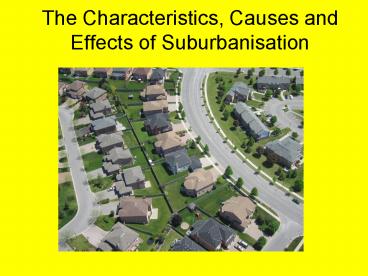The Characteristics, Causes and Effects of Suburbanisation - PowerPoint PPT Presentation
1 / 17
Title:
The Characteristics, Causes and Effects of Suburbanisation
Description:
Title: PowerPoint Presentation Created Date: 1/1/1601 12:00:00 AM Document presentation format: On-screen Show Other titles: Arial Default Design The Characteristics ... – PowerPoint PPT presentation
Number of Views:24
Avg rating:3.0/5.0
Title: The Characteristics, Causes and Effects of Suburbanisation
1
The Characteristics, Causes and Effects of
Suburbanisation
2
Suburbanisation
- The movement of people from the city centre to
lower density housing on the outskirts of a city.
- As urbanisation increases city centres become
overcrowded and people want more space.
Improvements to public transport mean people can
live further away but still reach the city centre
easily.
3
- As megacities grow, more suburbs are added so
older suburbs arent on the outskirts anymore. - A complex pattern of wealth and poorer areas
develops. Wealthy people live in suburbs on the
outskirts of the city because they can afford
larger houses with more space. Wealthy people
also move into poorer suburbs closer to the
centre and renovate the houses- this process is
called gentrification
4
Suburbanisation- the term has 2 meanings
- The outward growth of the suburbs as they eat
their way into the countryside on the urban
fringes. - The range of changes that take place as people
move into the outer suburbs, the market towns and
the villages of the countryside around cities.
These migrants change the countryside
economically, socially, demographically and
culturally.
5
- Can you think of what these changes might be in a
MEDC?
6
Changes to the countryside of suburbanisation
- Ageing population through retirees settling in
the countryside. - Rising property values that cause problems for
established local families on low incomes
(especially young couples buying their first
homes) - Closure of services such as village school, shops
and bus services, as they are less likely to be
patronised by newcomers. - Greater politicisation of green issues, as
newcomers bring with them much more Nimbyist
attitudes.
7
The Processes Associated with suburbanisation.
- Use the sorting cards to categorise the
demographic, economic, technological, social and
cultural changes associated with suburbanisation.
8
Demographic Changes
- Ageing population
- Rural depopulation
- Suburbanisation and second homes
9
Economic Changes
- Primary sector changes- decline of traditional
farming. Increase in hobby farming. More
non-agricultural land use. - Tertiary sector changes- increased influence of
tourism and a decline in the number of services.
10
Technological Changes
- Increased accessibility
- More work carried out at home
11
Social Changes
- More professional middle classes
- Fewer farm workers
- More retired people
- Therefore rural gentrification and so a rise in
rural house prices.
12
Cultural Changes
- Media changing of peoples perceptions, therefore
decline of rural traditions. - Introduction of more middle class culture,
therefore more environmental lobbying.
13
- Can you think of some MEDC case study examples
where you see suburbanisation taking place?
14
Question
- Assess the effects of suburbanisation on cities
within countries of different levels of economic
development - (10 marks).
15
Mark scheme
- Level 1 simple statements of effects which could
apply to a wide range of suburbanisation. There
is limited use of case study material and no
overall assessment is given. - (1-4 marks)
16
- Level 2 Statements of effects that are
sophisticated and/or linked to specific areas of
study. Good use is made of exemplification to
support the answer. Marks in the upper range
should be awarded for clear references to
suburbanisation within urban areas at different
levels of economic development. Assessment is
tentative and implicit. - (5-8 marks)
17
- Level 3 A fully developed answer, with good
elaboration and clear detail of the effects of
suburbanisation with the chosen urban areas.
Statements of assessment are explicit. - (9-10 marks)
- Note the key word is assess therefore you must
make some judgement of the effects of
suburbanisation on the chosen areas referred to.
You must refer to at least 2 different countries
at different stages of economic development- good
use of case study material is necessary. A
wholly general or theoretical answer will have
difficulty accessing the higher levels.































